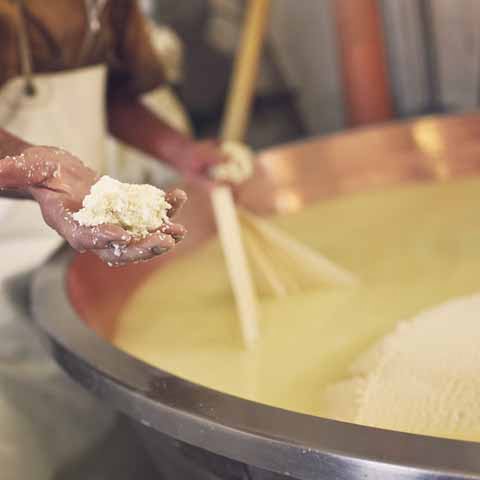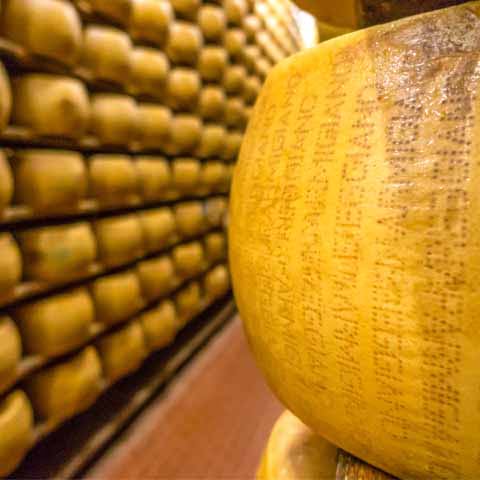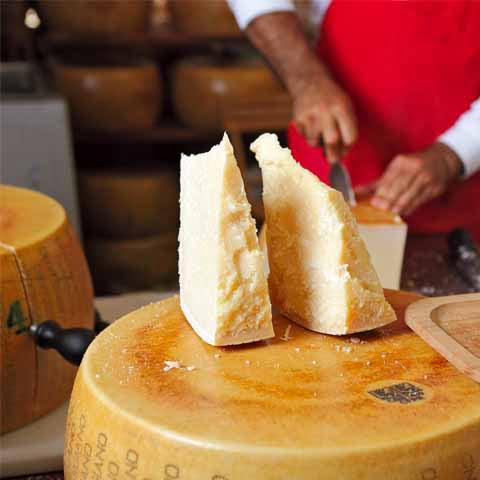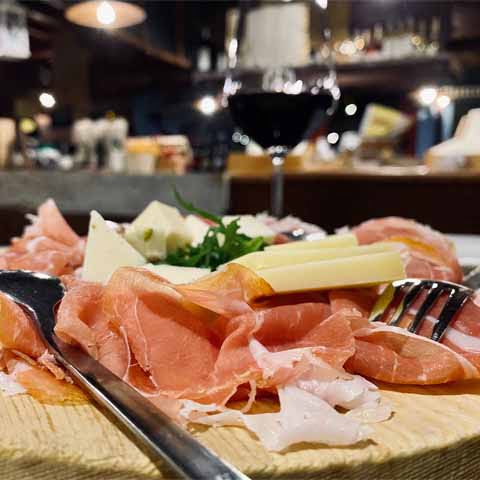Parma is a city with plenty to offer, and it has been a key contributor to Italy’s gastronomical core for centuries. From the cheeses to the pasta, the array of ingredients utilized provides for robust and distinguished flavors as well as deeply traditional recipes. From generation to generation, local artisans carry on the methods and expertise they are so proud of.
With Modena to its north and Bologna to its south, Parma is a star in Italian cuisine. It was the first city to be named the UNESCO Creative City for Gastronomy and is the seat of both the European Food Safety Authority and ALMA, the International School of Italian Cuisine. The most foods certified as DOP or IGP originate from the Emilia-Romagna region, including: Parmigiano Reggiano, Prosciutto di Parma, Culatello di Zibello, Salame Felino, and Fungo di Borgotaro.
Located in the Northern Italy region of Emilia-Romagna, the landscape in and around Parma plays a significant role in the superior ingredients and resulting dishes that the city is famous for. The countryside of the Po River Valley consists of flat lands as well as rolling hills; the perfect environment to produce high quality wheat and nurture the livestock that ultimately yields cheese, butter, veal and pork. The wetlands foster superior rice, freshwater fish, and game birds whereas the rocky Apennine Mountain range provides lower temperatures that are ideal for the region’s famed cured meats. Additionally, the nearby coast is the major source for the seafood used in many local dishes.
Of particular interest to foodies are the province of Parma’s food museums that are dedicated to the area’s characteristic local products and enhance any culinary journey to the city. This network includes the Parmigiano-Reggiano Museum in Soragna, the Prosciutto Museum in Langhirano, the Tomato Museum in Giarola, the Salame Musuem in the Castle of Felino, the Pasta Museum in Collecchio, and the Wine Museum in Sala Baganza. Travelers eager to learn even more about production of these traditional delicacies should consider tours of the various culinary factories located throughout the so-called “Food Valley.”
APPETIZERS
Favorite appetizers in Parma consist of cured meats and local cheeses. There is a larger population of pigs in Parma than people, so it should be no surprise that pork is widespread in local cuisine.
Prosciutto di Parma is said to be the “king” of the numerous pork products making the menu. This dry-cured, uncooked ham has a subtle and sweet taste due to the unique salting method in the fresh air of the rolling hills. Made out of a pig’s back thigh or leg, prosciutto can take anywhere from nine months to over two years to be fully produced. Parma’s famous variation is unique in that the pigs are frequently fed Parmigiano-Reggiano whey, which results in a nut-like flavor to the meat. While many regions have their own type of prosciutto, Parma’s is highly protected under the Protected Designation of Origin (PDO), ensuring the entire production process stays local. Prosciutto di Parma is a favorite on any tagliere, or cold cut spread, as well as on bread with other ingredients as a sandwich.
Other frequent appetizer favorites include: salame di Felino, spalla cotta, cicciolata, and Parmigiano-Reggiano cheese. The last of this list is considered to be the most highly-revered Italian cheese and is often called “the King of Cheeses.” Parmigiano-Reggiano is produced following specific protocols that determine its aging process (at least 12 months) and the areas in which it can be produced (the entire provinces of Parma, Reggio Emilia, and Modena, as well as parts of the provinces of Bologna and Mantua).
Torta fritta is often served alongside cured meats and cheeses as an added flavor and texture. This salted dough is fried to perfection, leaving it lightly toasted on the outside and soft and delicious on the inside.
FIRS COURSE
Following the appetizer, a popular choice is a dish of handmade pasta, such as tagliatelle, tortelloni, anolini, stuffed ravioli, and lasagne alla bolognese.
Anolini in particular are unique to Parma. The stuffed pasta is filled with Parmigiano-Reggiano cheese, stale bread, egg yolk, and leftover sauce from beef stew. This filling separates anolini from stuffed pasta found in other parts of the region. Anolini are usually enjoyed in the winter, particularly during the holiday season or special occasions and are served with broth or a rich sauce.
Tortelli d’erbetta is another traditional pasta dish native to Parma. The egg-pasta is filled with ricotta, Parmigiano-Reggiano, spinach, eggs, and nutmeg. The customary way to serve tortelli is with plenty of melted butter and Parmigiano-Reggiano cheese.
Many of the other pasta dishes were born throughout Emilia-Romagna. The stuffed pastas vary in contents including cheese, meat, herbs, and minced vegetables such as spinach and potato.
Though it did not originate in Parma, the locals enjoy the staple dish of Bologna, which is tagliatelle alla bolognese. The traditional dish consists of fresh egg pasta served with a decadent meat sauce that cooks slowly for several hours until it is bursting with flavor.
SECOND COURSE
The secondo course is a bit heavier with its traditional meat headliner. One excellent second course dish is known as bollito ripieno, which consists of stuffed hen or capon that is slowly simmered with spices such as nutmeg and cloves, and served with breadcrumbs and grated Parmigiano-Reggiano.
Other options that may be served at this point in the meal include stuffed veal, tripe, cured pork or ham, and horse meat. The latter is eaten both raw and cooked. In raw form, called caval pist, the meat is finely diced and mixed with olive oil, fresh lemon juice, Parmigiano Reggiano cheese and salt and pepper. Those preferring their meat cooked can find it served up with onions and pepper in a dish called vècia, or as a base for meatballs.
The classic dish known as trippa alla parmigiana is the traditional tripe dish of the Emilia-Romagna region. Part of the historic peasant cooking tradition, the dish is made with veal tripe, Parmigiano-Reggiano, and butter.
SIDES & CONDIMENTS
Those enjoying a meal in Parma cannot go wrong with adding Parmigiano-Reggiano to just about any dish. Dating back to the fourteenth century, this leader of Italian cheeses is produced daily by the some of the best cheese masters in the world. Another PDO designated food, it is made of just milk, salt, and rennet. The complex production process includes a lengthy aging period typically ranging from 12-18 months for a mild taste to at least 2 years for a stronger variety. This cheese compliments most everything in Italian cuisine whether it is grated, crumbled, shredded, or sliced.
The historically produced Balsamic Vinegar of Modena is another Emilia-Romagna masterpiece that perfectly accents Italian cuisine. Its powerful balance of sweet and acidic flavors perfectly enhances the food it’s drizzled upon.
Along with the traditional vegetable-based side dishes, mushrooms such as the Fungo di Borgotaro IGP and truffles such as the Tartufo Nero di Fragno go along with many Italian meals. From antipasti to second courses, the Fungo di Borgotaro IGP may be served raw, baked, sauteed, grilled, or dried. Both the mushroom and the truffle are often used as a filler for pasta, a topping on pizza, or to add flavor to meat, soup, or sauce recipes.
STREET FOOD
What would the “City of Gastronomy” be without its own take on street food? Parma even has its own festival dedicated to the convenient, on-the-go cuisine. In the spring, food trucks gather in Piazzale della Pilotta at the heart of the city to show off local specialties. Attendees can grab a taste of items such as anolini, torta fritta, horse meatballs, and a variety of fried goodies. To top off a day of enjoying the festival’s music, cooking demonstrations, and other lively events, visitors can enjoy fresh gelato, locally brewed artisan beer, or local wines such as Lambrusco.
The aforementioned caval pist may also be enjoyed as a street food when it is stuffed inside Parma’s typical bread (micca di Parma) to make a sandwich.
DESSERT
To put the perfect finishing touch on a Parma meal, it takes an amazing dessert. While locals take pride in their delicious stuffed pastas, similarly stuffed pastries are winners as well. Available in local bakeries, Tortelli dolci is a sweet, super-sized variety of its pasta counterpart. The exterior is a crispy shortcrust, while the inside is traditionally stuffed with a plum or apricot preserve.
Other desserts not to be missed while in Parma are spongata – cake with a filling of mixed nuts, dried fruit, raisins, cinnamon, nutmeg, and a mild white wine, and zuppa Inglese – an Italian take on the traditional English Trifle consisting of custard and liqueur-moistened biscuits or sponge cake.
Another favorite is the pattona, also called castagnaccio di Parma, which is a chestnut-flavored cake made with chestnut flour. One very special local cookie is only available around January 13; scarpette di Sant’Ilario are shoe-shaped cookies made in honor of one of Parma’s patron saints, Sant’Ilario.
WINE
Roughly 15% of the country’s wine is produced in the Emilia-Romagna region, and Parma is a significant contributor. The hills bordering the city are home to a few premium wines: Bonarda and Barbera are both red wines, yet each provides their own unique experience. Bonarda is dry with a fruity sweetness that accents sharp cheeses, meat, and pasta quite well. Barbera is dry while giving off a harsh and flavorful taste. Malvasia is a fragrant white wine that pairs well with fish, white meat, and pasta. Lastly, Lambrusco is a red wine with a sweet flavor that is most commonly available in a sparkling version. This vino is popular with cold meat and cheese appetizers.
There is no denying that Parma is famous for its food, and for good reason. The land of Parmigiano-Reggiano, Prosciutto di Parma, delicious handmade pasta, and flavorful red wines beckons to all self-proclaimed foodies as a haven of gastronomy.
Travel Guides
The Emilia Romagna Region of Italy
The Cities of Emilia Romagna, Italy











